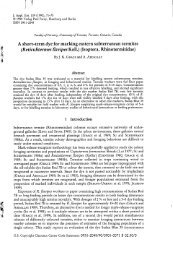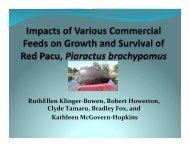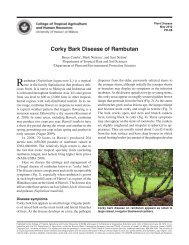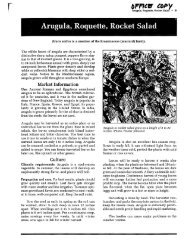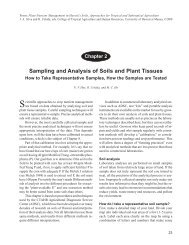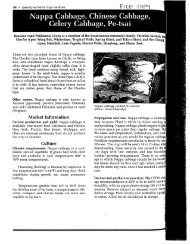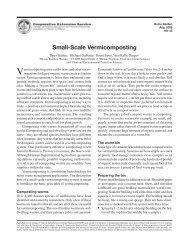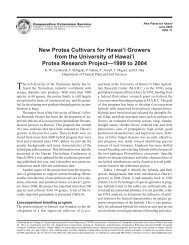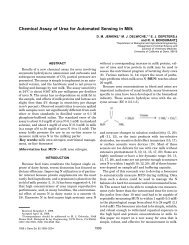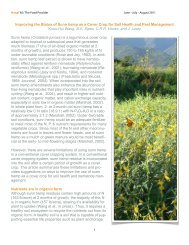Macadamia Nuts in Hawaii: History and Production - ctahr ...
Macadamia Nuts in Hawaii: History and Production - ctahr ...
Macadamia Nuts in Hawaii: History and Production - ctahr ...
You also want an ePaper? Increase the reach of your titles
YUMPU automatically turns print PDFs into web optimized ePapers that Google loves.
take place throughout the year, <strong>and</strong> nut season is<br />
year-round. 'Kakea' (HAES 508) especially shows<br />
this characteristic. Depend<strong>in</strong>g on the variety <strong>and</strong><br />
climatic conditions, Jones <strong>and</strong> Shaw (30) report<br />
that nuts on the tree are mature approximately 215<br />
days after anthesis (flower<strong>in</strong>g). Although the nuts<br />
are mature on the trees, field experience has shown<br />
that they do not beg<strong>in</strong> dropp<strong>in</strong>g until eight or<br />
n<strong>in</strong>e months after anthesis. Further maturity<br />
research is <strong>in</strong>dicated here.<br />
Harvest<strong>in</strong>g<br />
Harvest<strong>in</strong>g can be the s<strong>in</strong>gle most expensive<br />
operation, s<strong>in</strong>ce large losses, especially <strong>in</strong> nut<br />
quality reduction, can result from improper harvest<strong>in</strong>g<br />
method or schedul<strong>in</strong>g. Except <strong>in</strong> mechanical<br />
tree shak<strong>in</strong>g, mature nuts drop off the tree <strong>and</strong><br />
rema<strong>in</strong> on the ground until picked up by mach<strong>in</strong>e<br />
or by h<strong>and</strong>. While on the ground, the nuts can be<br />
eaten by rats, or they can become moldy through<br />
m<strong>in</strong>ute cracks <strong>in</strong> the nutshell or a faulty formation<br />
at the nut micropyle. Either way the losses can be<br />
substantial. Consequently, the nut harvest<strong>in</strong>g<br />
schedule has to be rigidly ma<strong>in</strong>ta<strong>in</strong>ed <strong>and</strong> followed<br />
<strong>in</strong> any given area. The rat population, leaves <strong>and</strong><br />
other debris under the tree, periodic ra<strong>in</strong>fall pat-<br />
tern, air movement through the field, sunlight<br />
penetration under the tree, <strong>and</strong> the general humidity<br />
<strong>in</strong> the orchard should be considered <strong>in</strong> determ<strong>in</strong><strong>in</strong>g<br />
<strong>in</strong>tervals of harvest. Generally, an <strong>in</strong>terval<br />
approach<strong>in</strong>g four weeks is a good po<strong>in</strong>t to start<br />
from to work toward shorten<strong>in</strong>g or lengthen<strong>in</strong>g<br />
the period to suit the conditions of the area.<br />
In h<strong>and</strong> harvest<strong>in</strong>g, nuts are picked up <strong>in</strong><br />
buckets, temporarily stored <strong>in</strong> bags, <strong>and</strong> loaded on<br />
trailers or trucks to be hauled to the husk<strong>in</strong>g stations.<br />
The bulk of h<strong>and</strong> harvest<strong>in</strong>g is done by hired<br />
labor or by contract labor on a per-bag cost basis.<br />
Mechanical harvest<strong>in</strong>g off the ground is practiced<br />
by large growers us<strong>in</strong>g three separa te mach<strong>in</strong>es:<br />
a leaf blower (Fig. 78), a nut sweeper (Fig.<br />
79), <strong>and</strong> a harvester (Fig. 80). In mechanical harvest<strong>in</strong>g,<br />
after the area is blown clear of leaves <strong>and</strong><br />
debris, the sweeper brushes the nuts <strong>in</strong>to w<strong>in</strong>drows<br />
between two rows of trees for the pickup harvester,<br />
which is a mach<strong>in</strong>e with rubber f<strong>in</strong>ger scrolls to<br />
kick the nuts onto a cross conveyor belt, which, <strong>in</strong><br />
turn, empties the nuts onto a lift conveyor to be<br />
elevated <strong>and</strong> f<strong>in</strong>ally dumped <strong>in</strong>to a towed trailer.<br />
A new model of this harvester uses two synchronized<br />
high-velocity rotation reels to elim<strong>in</strong>ate<br />
twig <strong>and</strong> leaf uptake.<br />
Figure 78. Self-propelled blower to rid the field of leaves before sweep harvest<strong>in</strong>g.<br />
59



